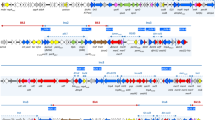Abstract
This study focused on the molecular characterization of a small cryptic, mobilizable plasmid (6038 bp) sequenced from an E. faecium 9631160-1 of poultry origin. Sequence analysis of pRI1 revealed seven open reading frames. pRI1 contained an IS 100% identical to ISEfa4. This insertion element disrupted a putative mobilization gene (mobA) which presented 99% similarity to the one described in plasmid pJS42 (NC_010291). pRI1 harbored a cluster of four coding sequences which exhibited a homology to those described in contig 658 (from nucleotide 8940 to nt 10515) of E. faecium DO. In addition, a rep almost identical to the repA from the pEFNP1 and pKQ10 plasmids from E. faecium was also identified. Presence of the pRI1 replication initiation gene (rep) was analyzed in a panel of 159 E. faecium isolates of human and animal origin from different European countries, of which 60 tested positive for the presence of pRI1-rep. Conjugation experiments verified transfer of the pRI1 together with conjugative plasmids harboring resistance to vancomycin and streptogramin. The presence of pRI1 in enterococcal isolates geographically separated and from different origin demonstrates the ability of enterococci to acquire and transfer mobile genetic elements, emphasizing the need for further studies to reveal the meaning and role that these cryptic plasmids play in nature.


Similar content being viewed by others
References
Altschul SF, Madden TL, Schaffer AA, Zhang J, Zhang Z, Miller W, Lipman DJ (1997) Gapped BLAST and PSI-BLAST: a new generation of protein database search programs. Nucleic Acids Res 25:3389–3402
Bennett PM (2008) Plasmid encoded antibiotic resistance: acquisition and transfer of antibiotic resistance genes in bacteria. Br J Pharmacol 153(Suppl 1):S347–S357
Bentley WE, Kompala DS (1990) Optimal induction of protein synthesis in recombinant bacterial cultures. Ann NY Acad Sci 589:121–138
Clewell DB (1990) Movable genetic elements and antibiotic resistance in enterococci. Eur J Clin Microbiol Infect Dis 9:90–102
Clewell DB, An FY, White BA, Gawron-Burke C (1985) Streptococcus faecalis sex pheromone (cAM373) also produced by Staphylococcus aureus and identification of a conjugative transposon (Tn918). J Bacteriol 162:1212–1220
Clewell DB, Dunny GM (2002) Conjugation and genetic exchange in enterococci. In: Gilmore MS (ed) The enterococci: pathogenesis, molecular biology and antibiotic resistance. American Society for Microbiology, Washington, DC, pp 265–300
de la Cruz F, Davies J (2000) Horizontal gene transfer and the origin of species: lessons from bacteria. Trends Microbiol 8:128–133
Depardieu F, Reynolds PE, Courvalin P (2003) VanD-type vancomycin-resistant Enterococcus faecium 10/96A. Antimicrob Agents Chemother 47:7–18
Garcia-Migura L, Pleydell E, Barnes S, Davies RH, Liebana E (2005) Characterization of vancomycin-resistant Enterococcus faecium isolates from broiler poultry and pig farms in England and Wales. J Clin Microbiol 43:3283–3289
Guglielmetti S, Mora D, Parini C (2007) Small rolling circle plasmids in Bacillus subtilis and related species: organization, distribution, and their possible role in host physiology. Plasmid 57:245–264
Hammerum AM, Flannagan SE, Clewell DB, Jensen LB (2001) Indication of transposition of a mobile DNA element containing the vat(D) and erm(B) genes in Enterococcus faecium. Antimicrob Agents Chemother 45:3223–3225
Hammerum AM, Jensen LB, Aarestrup FM (1998) Detection of the satA gene and transferability of virginiamycin resistance in Enterococcus faecium from food-animals. FEMS Microbiol Lett 168:145–151
Hasman H, Kempf I, Chidaine B, Cariolet R, Ersboll AK, Houe H, Bruun Hansen HC, Aarestrup FM (2006) Copper resistance in Enterococcus faecium, mediated by the tcrB gene, is selected by supplementation of pig feed with copper sulphate. Appl Environ Microbiol 72:5784–5789
Jensen LB, Hammerum AM, Aarestrup FM (2000) Linkage of vat(E) and erm(B) in streptogamin-resistant Enterococcus faecium isolates from Europe. Antimicrob Agents Chemother 44:2231–2232
Khan SA (1997) Rolling-circle replication of bacterial plasmids. Microbiol Mol Biol Rev 61:442–455
Klare I, Werner G, Witte W (2001) Enterococci habitats, infections, virulence factors, resistances to antibiotics, transfer of resistance determinants. Contrib Microbiol 8:108–122
Kuhn I, Iversen A, Finn M et al (2005) Occurrence and relatedness of vancomycin-resistant enterococci in animals, humans, and the environment in different European regions. Appl Environ Microbiol 71:5383–5390
Lim SK, Tanimoto K, Tomita H, Ike Y (2006) Pheromone-responsive conjugative vancomycin resistance plasmids in Enterococcus faecalis isolates from humans and chicken feces. Appl Environ Microbiol 72:6544–6553
Macrina FL, Evans RP, Tobian JA, Hartley DL, Clewell DB, Jones KR (1983) Novel shuttle plasmid vehicles for Escherichia-Streptococcus transgeneric cloning. Gene 25:145–150
Marchler-Bauer A, Anderson JB, Derbyshire MK et al (2007) CDD: a conserved domain database for interactive domain family analysis. Nucleic Acids Res 35:D237–D240
Martinez-Bueno M, Valdivia E, Galvez A, Maqueda M (2000) pS86, a new theta-replicating plasmid from Enterococcus faecalis. Curr Microbiol 41:257–261
Meijer WJ, Wisman GB, Terpstra P, Thorsted PB, Thomas CM, Holsappel S, Venema G, Bron S (1998) Rolling-circle plasmids from Bacillus subtilis: complete nucleotide sequences and analyses of genes of pTA1015, pTA1040, pTA1050 and pTA1060, and comparisons with related plasmids from gram-positive bacteria. FEMS Microbiol Rev 21:337–368
Takase K, Kakinuma S, Yamato I, Konishi K, Igarashi K, Kakinuma Y (1994) Sequencing and characterization of the ntp gene cluster for vacuolar-type Na(+)-translocating ATPase of Enterococcus hirae. J Biol Chem 269:11037–11044
Zawadzki P, Riley MA, Cohan FM (1996) Homology among nearly all plasmids infecting three Bacillus species. J Bacteriol 178:191–198
Acknowledgments
This study was supported by the European Union Sixth Framework Programme “Approaches to Control Multi-resistant Enterococci (ACE): Studies on Molecular Ecology, Horizontal Gene Transfer, Fitness and Prevention,” under contract LSHECT-2007-037410. We would like to thank Professor Manolo Espinosa for his advice regarding the plasmid biology of pRI1. We gratefully acknowledge Resadije Idrizi at the National Food Institute for her technical support.
Author information
Authors and Affiliations
Corresponding author
Rights and permissions
About this article
Cite this article
Garcia-Migura, L., Hasman, H. & Jensen, L.B. Presence of pRI1: A Small Cryptic Mobilizable Plasmid Isolated from Enterococcus faecium of Human and Animal Origin. Curr Microbiol 58, 95–100 (2009). https://doi.org/10.1007/s00284-008-9266-x
Received:
Revised:
Accepted:
Published:
Issue Date:
DOI: https://doi.org/10.1007/s00284-008-9266-x




